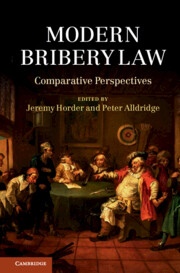Book contents
- Frontmatter
- Contents
- List of contributors
- Table of cases
- Table of statutes and international instruments
- Introduction
- Part I Bribery law: between public wrongdoing and private advantage-taking
- Part II Bribery without borders: tackling corruption in the EU and beyond
- Part III Ill-gotten gains: the challenge of prosecution, enforcement and asset recovery
- 8 Bribery and the changing pattern of criminal prosecution
- 9 Bribery and corruption: the UK framework for enforcement
- 10 Prosecuting bribery in Hong Kong's human rights environment
- 11 Is the UNCAC an effective deterrent to grand corruption?
- Bibliography
- Index
11 - Is the UNCAC an effective deterrent to grand corruption?
from Part III - Ill-gotten gains: the challenge of prosecution, enforcement and asset recovery
Published online by Cambridge University Press: 05 May 2013
- Frontmatter
- Contents
- List of contributors
- Table of cases
- Table of statutes and international instruments
- Introduction
- Part I Bribery law: between public wrongdoing and private advantage-taking
- Part II Bribery without borders: tackling corruption in the EU and beyond
- Part III Ill-gotten gains: the challenge of prosecution, enforcement and asset recovery
- 8 Bribery and the changing pattern of criminal prosecution
- 9 Bribery and corruption: the UK framework for enforcement
- 10 Prosecuting bribery in Hong Kong's human rights environment
- 11 Is the UNCAC an effective deterrent to grand corruption?
- Bibliography
- Index
Summary
Introduction
This chapter is about corruption on a grand scale, as encountered in a number of well-publicised cases. All predate the UK’s Bribery Act 2010 (‘the 2010 Act’), and concentrate on efforts to thwart the perpetrators or to recover the proceeds of the corruption which took place. Time will tell how effective the 2010 Act will be in helping to curb corruption on the scale practised in these examples; although bribery was certainly present in many of the cases, large-scale embezzlement, or theft of public funds, was also a recurrent feature. Consideration is given in the chapter to whether the United Nations Convention against Corruption (UNCAC) can assist in bringing this ‘kleptocracy’ to justice. In reading this chapter it should be borne in mind that the World Bank, in the Preface to its Asset Recovery Handbook, published at the beginning of 2011 as part of its Stolen Assets Recovery (StAR) initiative, stated that an estimated US$20–40 billion is siphoned out of developing countries each year: to date only US$5 billion has been recovered, and probably half of that is accounted for by the Abacha case, referred to below.
The chapter will also touch on the growing evidence that governments in states where there is a history of grand corruption continue to actively collude in corrupt practices and to take steps which thwart the aims and objectives of UNCAC, despite having ratified the Convention and claiming to implement its provisions.
- Type
- Chapter
- Information
- Modern Bribery LawComparative Perspectives, pp. 293 - 327Publisher: Cambridge University PressPrint publication year: 2013



